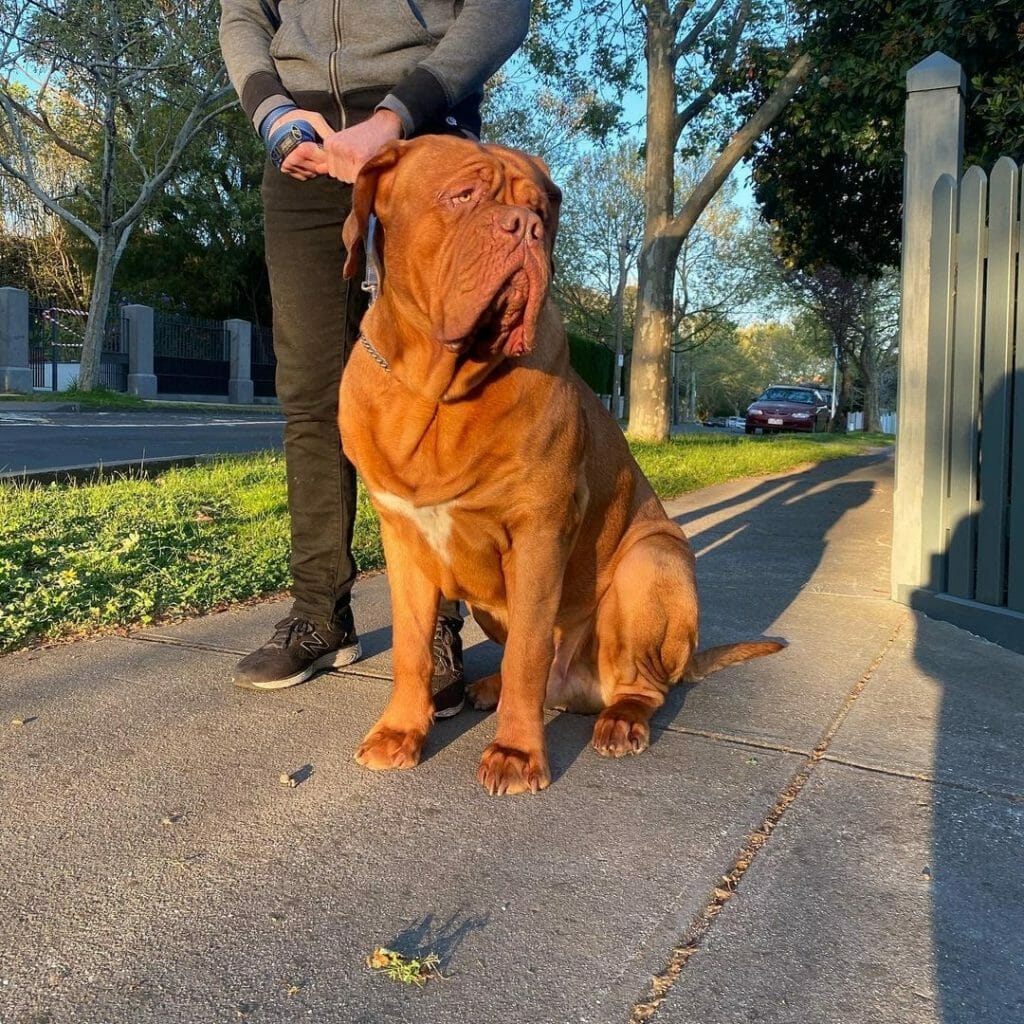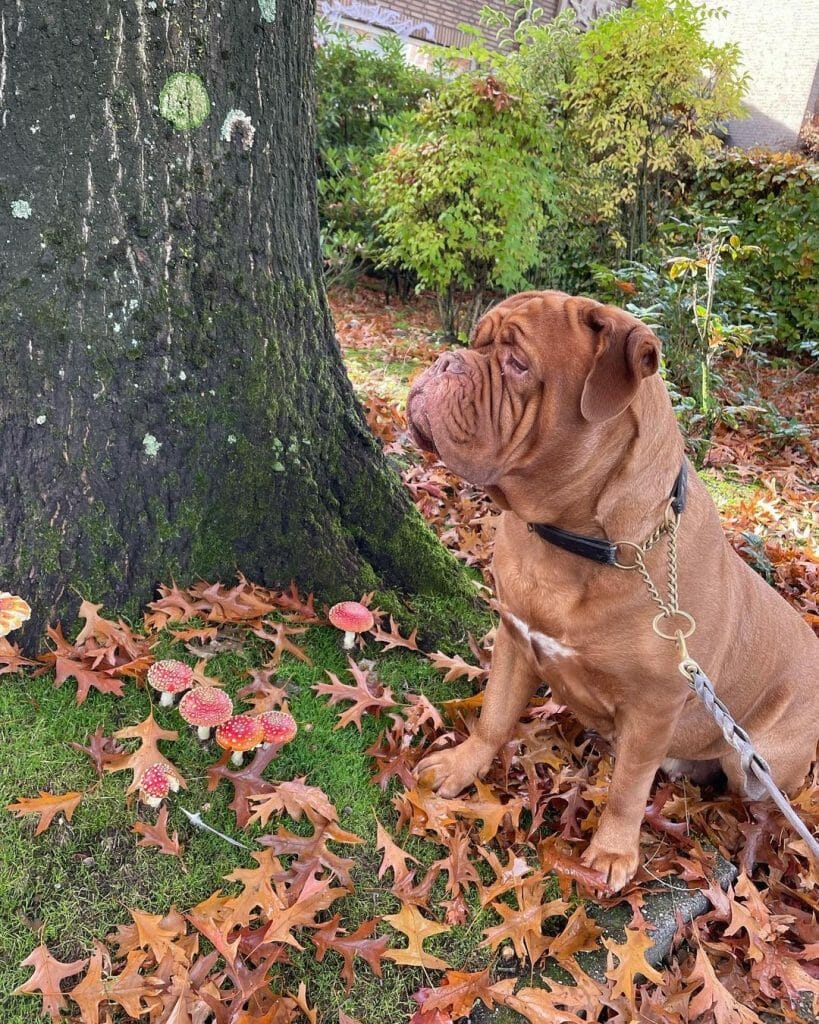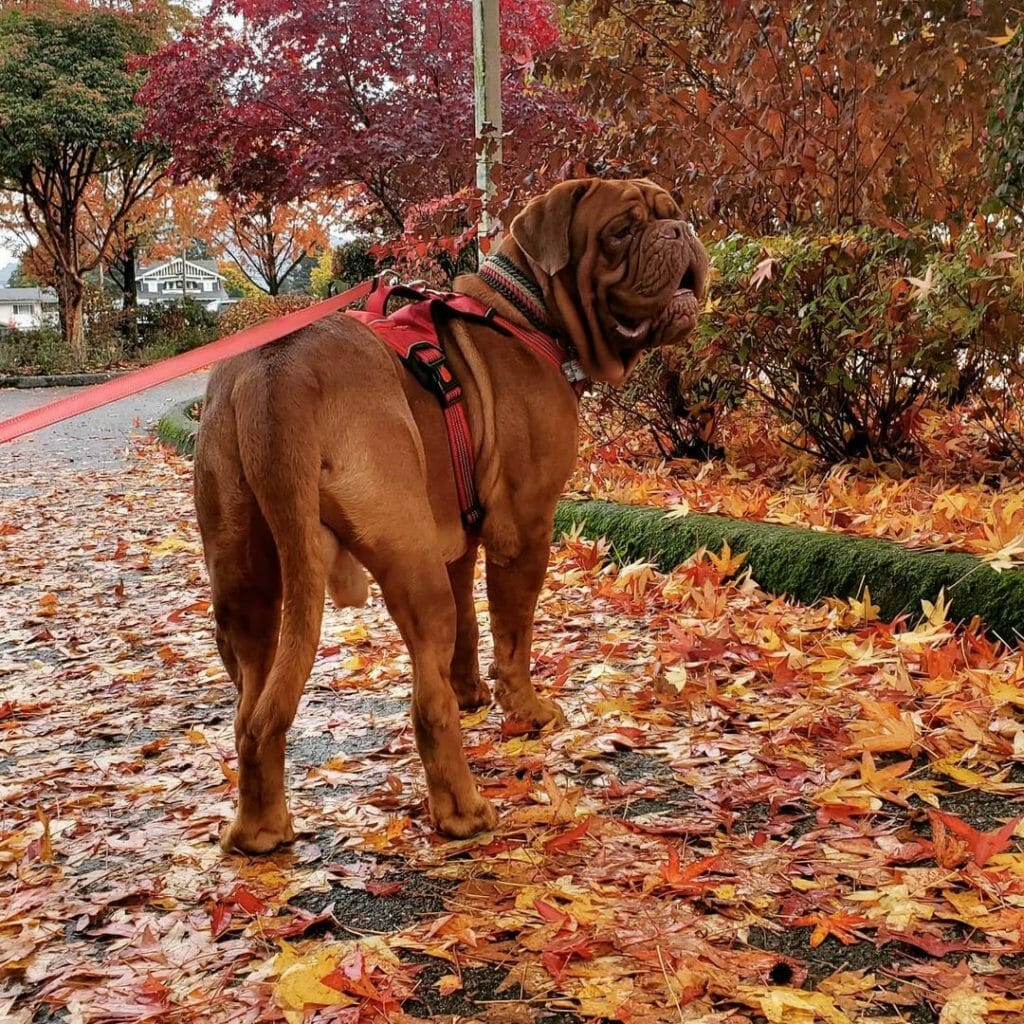Dogue de Bordeaux 101: The Essential Guide
| Origin | France |
| Size | Large |
| Height | 23 to 27 inches |
| Weight | 99 to 110 (up) pounds |
| Life Expectancy | 5 – 8 years |
| Breed Group | Working Group |
| Affection Level | ⭐⭐⭐ |
| Friendliness | ⭐⭐ |
| Activity Level | ⭐ |
| Barking/Howling Level | ⭐ |
| Pet Friendly | ⭐ |
| Kid-Friendly | ⭐⭐⭐ |
| Shedding | ⭐⭐ |
| Easy to Groom | ⭐⭐⭐ |
| Easy to Train | ⭐ |
Table of Contents
Origin


The Dogue de Bordeaux, also known as the French Mastiff, comes from the great Molosser who is known for its robust and solidly built body. This ancient Molossian Hound has branched out several well-known breeds including the Mastiffs, Pugs, and Saint Bernards.
The name Dogue De Bordeaux means “Bordeaux Mastiff” in English, highlighting its origin in the Bordeaux region of France and its classification as a mastiff-type breed.
France’s Bordeaux Dog’s records are not enough to tell us how exactly he came to be, but several conjectures would say that he descended from the Spanish dog breed called the Alano. Others speculate that the French Mastiff is close to the Tibetan Mastiff while others believe that the closest potential ancestor is a French dog breed known as the Dogues de Bordeaux of Aquitaine.
Several documents and records indicate further that the French Mastiff occurred earlier than the Bullmastiff and the Bulldog. In fact, it’s possible that the French dog contributed a lot to the latter mentioned breeds. However, other cases would also suggest that both the Bullmastiff and the Bulldog helped develop the French Mastiff.
In the 1800s, the French Mastiff was deployed in various parts of France and was largely used to bait bulls and other wild animals. He was also part of hunting groups that would go after boars. Guarding properties and herding the cattle were also part of his duties. Furthermore, this breed contributed to the improvement of breeds like the Dogo Argentino and Japan’s Tosa breed.
Appearance


Being part of the Mastiff family, the first thing you’d notice from the French Mastiff is his massive size. This is one large dog with an impressive and solid build. He’s stocky with an appearance close to Bulldogs thanks to his brachycephalic facial structure.
Male French Mastiffs are typically larger than females and while they may exceed great proportions, the American Kennel Club has set the ideal height and weight:
| Gender | Height | Weight |
| Female | 23 to 26 inches | 99 pounds and up |
| Male | 23 to 27 inches | 110 pounds and up |
Descriptions regarding his looks include a large head with a short muzzle, loose skin around his mouth and neck, jowls that hang freely under his jaw, and wrinkles that form on his face. The quality of his coat is surprisingly soft and during his early years as a breed, various coat colors are available. Later on, the natural colors that mainly appeared for him are:
- Fawn
- Red
- Mahogany
The color of his nose is dependent on his coat color and the two possibilities are brown or isabella. Various white spots or patches can be present, but it is faulty for him to have the mark on the tip of his tail.
Temperament
Mastiffs have a widely known reputation as intimidating and ferocious dogs due to the history they have been rooted upon. However, they are not just best suited as protection dogs. In fact, they can offer more than these common services they are known to give to people and that is companionship.
Let’s get to know more about the French Mastiff’s likable temperament and behavioral traits!
Affection


The Dogue de Bordeaux is an incredibly affectionate breed whose loyalty never wanes towards his family. To have a more meaningful bond with him, it is best that you spend a considerable amount of time with this clingy dog to remind him of your love. Those whom he considered his family will be treated with the utmost respect.
His expressive eyes will tell you a lot about how he’s feeling. Oftentimes, the French mastiff will reluctantly sleep in his dog bed. This is because the best place to sleep would be on your lap! He loves being cuddled and petted. In other words, he’s got a huge appetite for affection. But, this does not come to the point that he’ll be too demanding and too much for anyone.
If you have kids, he’ll treat them with care. There are various ways he could show his love and this is mainly through his body language. It could either be a wagging tail, raised eyebrows, or eye contact.
Friendliness


Naturally, the Dogue de Bordeaux is friendly, especially to familiar people. If his owner comes home from work and is approaching the front door, this dog will greet him in the doorway with a wagging tail. He’s also amiable toward your kids. Dogs and kids who grew up together will develop a very special and unbreakable bond.
This behavior changes, however, when he meets a stranger. This dog is naturally protective and territorial, so aloofness or cautiousness may be exhibited towards the unfamiliar person. A trained French Mastiff shouldn’t be showing aggressive behavior right away but rather decipher if the stranger shows normal or threatening actions.
It is best not to approach a French Mastiff who doesn’t know you. Some dogs are not trained how to properly react around others and avoiding one will save you from the risk of getting injured.
Activity Level


The French Mastiff may be large but his size hinders him from having too much energy. It is simply quite hard work carrying such a heavy mass! Thankfully, since he’s not that enormous compared to the English Mastiff, you can expect him to do more as long as his tasks are moderated.
He is also known to be very adaptable. If his home encourages him to be a couch potato, he will think it is alright not to move and just laze on the couch. On the other hand, if he’s in a very outgoing and active family, he can surely keep up.
Some French Mastiffs love to be outside and socialize with other dogs. Just be wary about the weather since this breed overheats quite quickly. His body cannot regulate its temperature, especially if it is under the scorching sun.
Care
The French Mastiff seems to be a low-maintenance breed, but that does not mean he won’t need as much care as you would with other dogs like the Poodle. So, what’s the proper way of ensuring he lives a healthy lifestyle?
Grooming


The smooth and short coat of the French Mastiff requires routine grooming but not as frequent as you would think. Bathing him would only ideally take place between 6 to 8 weeks or whenever he gets muddy or dirty after his play. To keep his coat clean and vibrant, brush it thoroughly weekly or whatever works for you. Brushing him twice a week will do.
Whenever you groom your dog, don’t forget to check the other parts of the body that may be prone to infection. His ears should be clean and the same applies to his teeth. With his facial folds, ensure that you wipe them in between to get rid of trapped moisture. As for his nails, trim them when they get long. Don’t wait until you hear clicking noises as he walks on the floor. Be careful not to reach the quick whilst cutting down his nails.
Although his jowls are not extreme, you’ll still see strings of slobber around your carpets, furniture, or floor. You can carry a clean towel wherever you both go or tie a bib around his neck.
If he suffers from any conditions like ichthyosis, consult a vet so he can recommend the right medicated shampoo for your dog.
Food and Diet


Going for a sizable breed such as the Dogue de Bordeaux means committing yourself to allocate a bigger budget for his food. According to the National Research Council of the National Academies, a 140-pound French Mastiff would typically need a daily caloric intake of 2839 kcal. Those who have been spayed or neutered will have significantly lesser amounts of caloric needs.
Take into account that some French Mastiffs have varying levels of activity, age, health, and build. That means, there is no uniform amount of food in feeding this breed.
When considering what to feed a Dogue de Bordeaux, it’s crucial to prioritize a high-quality diet that includes premium dog food with meat as the primary ingredient, supplemented with vegetables and fruits.
Still, the general rules apply. You have to seriously consider your dog’s needs. A puppy will require a puppy-appropriate dog food or diet. A pup grows quickly in his first year so he would need to eat around 1800 kcal daily which is close to the amount an adult would eat. This is normal since development is an important process and he needs all nutrition he can get to support normal growth.
High-quality commercial dog food or a well-planned diet works best for any dog. Try to avoid dog foods that are high on fillers, preservatives, and MSG to name a few as they bring no benefit for your buddy. During your mealtime, resist the urge to feed this doggo your food scraps to prevent him from gaining too much weight.
Exercise


The French Mastiff is neither high nor low when it comes to energy levels. Exercises should not be lengthy. In fact, match his activity level with the right drills. Ideally, this dog should be encouraged to sweat off for an hour daily. You can divide this into shorter sessions to avoid him from becoming over-exhausted.
There are different ways on how to keep his weight down. You can let him play a game of fetch in a widely secure area and simply bring him out for a walk in the late afternoon.
Be aware that this French breed is highly prone to dysplasia, given its enormous size. During puppyhood, limit his playtime and discourage him from jumping around too much to avoid him from developing serious joint and bone issues, later in life.
Training


Some French Mastiffs are already taught basic training by their breeders before they get to their respective homes. Of course, once you get him, the drill must continue. Instill in him the important house rules and be consistent about it. It is always much better for a dog to be trained as early as possible.
The basic pieces of training he has to learn are:
- Crate training
- Basic verbal commands such as “sit”, “no”, “stay” or “stand”
- Obedience training
- Guard training
- Socialization
Training your French Mastiff is highly beneficial not just for him but also for you and your family. If he exhibits good behavior, there is less tension in the house. Meanwhile, if he grows up to be undisciplined, a lot of problems will show.
Socialization is one of the most essential training he’d need. His protective instinct should not show at all times when there is no reason to. Getting exposed to other dogs and people will teach him the advantages of being open and friendly.
You can hire a dog trainer if you can afford one, but even if you do, having you as his trainer is better than anyone else. You’ll get to understand him more and discover his quirky behaviors. Getting to know him as much as you can is key to a stronger relationship!
Health Problems
With a life span of 5 to 8 years, it can cause speculation that this dog suffers from many health problems, but no, it is his size that makes him age faster since he’s predisposed to reach more than a hundred pounds of weight. The truth is, he’s generally healthy, but just like other dogs, he can suffer from several health issues like cancer which is the primary killer of this breed.
Others include:
- Dilated cardiomyopathy
- Aortic stenosis
- Gastric torsion
- Hip dysplasia
- Dermatitis
- Ectropion
A reputable breeder runs his French Mastiffs to a series of health tests. There are health certificates which he can show to prove that the puppy you’re getting is healthy.
Moreover, even though the pup is robust, some issues develop later in life. Bring him to the vet regularly for early diagnosis and treatment.
Pros and Cons of Having a Dogue de Bordeaux
Pros
- He is easy-going and laid back
- He is extremely loyal to his owners
- Exercise is needed only in moderate amounts
- Generally even-tempered
- He is highly affectionate
- Grooming him is easy
- Typically quiet and calm indoors
- He’s fearless and excellent as a protector
- He’s capable of being left alone for some time
- Great with other kids
Cons
- He has an unfortunately very short lifespan
- He’s not the friendliest with other pets
- He drools a lot
- Can be stubborn, independent, and strong-willed
- Would require intense socialization training
- He would require wider space at home
- May show aggression when untrained
- Has high prey drive
- Has high likelihood to develop health problems
- Some US states ban this breed
Do Kennel Clubs Recognize the Dogue de Bordeaux?
The French Mastiff, despite being France’s oldest dog breed, was not recognized until 2008 when the American Kennel Club finally considered him as one of its official breeds. The Kennel Club (UK) also acknowledges the Dogue de Bordeaux. The breed standards for this dog were written in the 1970s.
Additionally, it was in 1982 when the French Mastiff was gradually known by the public thanks to Dr. Carl Semencic’s article, “Dog World” which featured the Dogue de Bordeaux.
Cost


The average price for a Dogue de Bordeaux runs up to $1,500 with a usual range of $900 to $2,700. The price largely depends upon the dog’s quality, breeder’s reputation, age, sex, demand and location, and many more. Pet-quality dogs are less expensive compared to those who have superior or champion bloodlines as well.
Puppies cost more than adult dogs, so if you’re’ tight on the budget, go for an older French Mastiff. Adoption is also another option. For only $300, you’ll get your dream Mastiff dog!
Take note of the average cost of owning a French Mastiff in his entire lifetime. That can reach up to $17,700!
Where to Adopt or Buy a Dogue de Bordeaux Puppy
The Dogue de Bordeaux might be the right breed for you! If after a thorough deliberation you have realized that you should get this as your family companion, looking for the best and trusted places to get him from is the next crucial step. Here’s a list of websites you might consider:
BUY
ADOPT
Once you have this French Mastiff in your arms, be sure to remember all the details written in this article! We love to be with you on your journey as a dog owner. As much as we can, we want you both to have a healthy relationship with each other!
